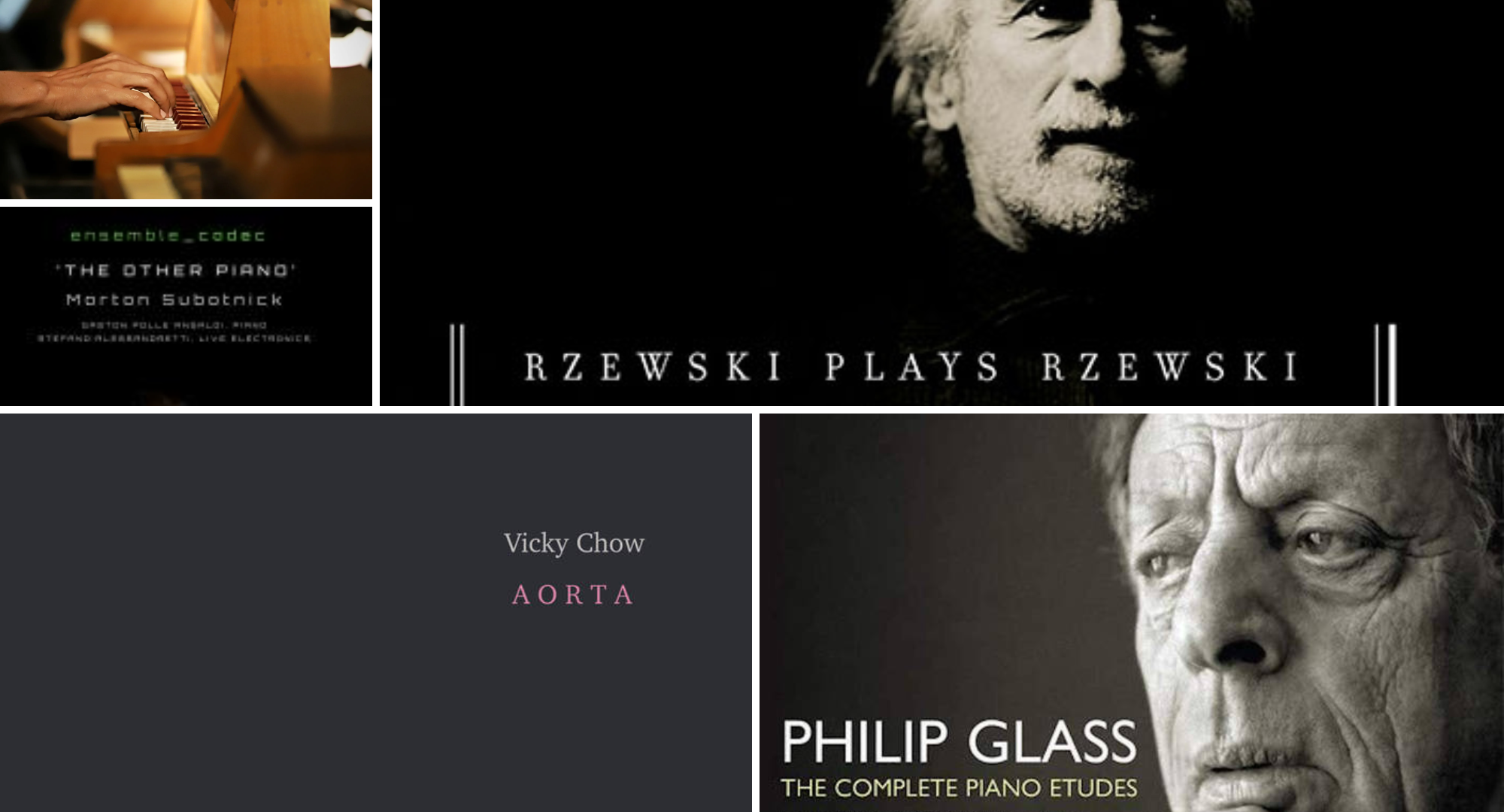I wanted to make the antithesis of a “Peaceful Classical Piano” type playlist. I don’t think I succeeded, as some of the works here are still very beautiful, however, I think the collective vibe does provide some relief from piano used as background music to which one should study or relax to.
To make sure these playlists delivered to your inbox every week, sign up for my newsletter.
I give this playlist a Difficult Listening Hour rating of 5/10.
hush – for two microtonal keyboards by Nina Shekhar. Read more here.
From the composer’s bio, “Nina Shekhar is a composer and multimedia artist who explores the intersection of identity, vulnerability, love, and laughter to create bold and intensely personal works.”
For Ligeti by Conlon Nancarrow played on the composer’s player piano.
From Wikipedia, “Samuel Conlon Nancarrow was an American-Mexican composer who lived and worked in Mexico for most of his life. Nancarrow is best remembered for his Studies for Player Piano, being one of the first composers to use auto-playing musical instruments, realizing their potential to play far beyond human performance ability. He lived most of his life in relative isolation and did not become widely known until the 1980s.”
Aeolian Harp by Henry Cowell performed by Carles Santos. Album: Obres de Cowell, Cage, Webern, Stockhausen i Mestres-Quadreny
From Wikipedia, “Carles Santos was a Spanish artist who began his career as a pianist and later worked in many other creative disciplines, including musical composition, filmmaking, screenwriting, acting, scenic musical shows, graphics, montage, sculpture, photography, poetry, and prose.”
Rave by Molly Joyce performed by Vicky Chow. Album: Aorta
“Molly Joyce is a composer and performer whose work focuses on disability as a creative source. She has been deemed one of the “most versatile, prolific and intriguing composers working under the vast new-music dome” – The Washington Post
Chiaroscuro by John Corigliano performed by Ursula Uppens. Album: Winging It: Piano Music of John Corigliano
From the program note, “Eventually, the deadline forced me to come up with a solution. What occurred to me, finally, was the idea to change totally the concept of two pianos by ‘preparing’ one of them. This was not to be a prepared piano in the John Cage sense, with objects inserted between the strings. Instead, one of the pianos would be tuned a quarter-tone lower than the other, in other words, each piano would sound perfectly tuned by itself, but, for example, the note G on one piano would sound at a pitch between G and F sharp on the other piano, creating eerie effects and dissonances when the instruments were played together.”
Miracle Ear by David Lang performed by Margaret Leng Tan. Album: Art of the Toy Piano
From the performance notes, “miracle ear was written for Margaret Leng Tan and is dedicated to my father, Daniel Lang, in honor of his seventieth birthday. miracle ear is the name of a brand of hearing aid that advertises on late-night TV.
I wanted to write a piece that was an appropriate gift for my father – something about the passage of time but not too morbid. Then I remembered a discussion I had had with him about hearing aids. My father now wears hearing aids in both ears and apparently they can create as many listening problems as they solve. In particular, hearing aids may not make listening to music any easier because they tend to boost the background noises and sounds associated with making music – breathing, attack, room noise, etc. – more than the music itself. Through the hearing aid, notes that were too soft to hear unaided become drowned out by all the other louder noises. In miracle ear, gentle and subtle rhythms in the toy piano are accompanied by the sharp attacks of metal pipes. This makes the music very difficult to hear.”
The Illusionist’s Magic Box by Paul Max Edlin performed by Tricia Dawn Williams.
Album: Tiny Keys Big Sounds
Study Nr. 47 by Conlon Nancarrow. Album: Nancarrow: Late and Unknown
Etude No. 2 & 20 by Philip Glass performed by Maki Namekawa. Album: Philip Glass: The Complete Piano Etudes
Suite for Toy Piano by John Cage performed by Stephen Drury. Album: In a Landscape: Piano Music of John Cage
Piano Sonata No. 1 by Carl Vine performed by Xiaoya Liu. Album: Carl Vine: Complete Piano Sonatas
North American Ballads: Which Side Are You On? by Frederic Rzewski. Album: Rzewski plays Rzewski, 1975-1999
From the LA Phil website, “The original protest song was written in the 1930s by Florence Reese, the wife of a union organizer in the Kentucky coal mines, to the tune of a Baptist hymn (Lay the Lily Low). The full tune is quoted only at the end, the composer beginning instead with fragments that suggest questions more than answers. There are meter and key changes throughout, across an extreme dynamic range, and Minimalist passages as well as an opportunity for improvisation.
“The structure of the melody illustrates the words, Which Side Are You On?,” Rzewski said in a dissertation interview with pianist Sujin Kim. “So, are you on this side? Or are you on that side? Are you supporting the miners? Or are you supporting the bosses? It’s a question. So the idea is that you have to be on one side or the other. The music is intended to illustrate that simple idea. So, it’s divided into two parts. The first section is complex, the second section is simple.” “
The Other Piano: Rocking by Morton Subotnick performed by ensemble Codec. Album: The Other Piano (Live in Studio)
From Wikipedia, “Morton Subotnick (born April 14, 1933) is an American composer of electronic music, best known for his 1967 composition Silver Apples of the Moon, the first electronic work commissioned by a record company, Nonesuch. He was one of the founding members of California Institute of the Arts, where he taught for many years.”
Piano Phase by Steve Reich performed by Album: Works: 1965–1995
Sierra by Jane Antonia Cornish performed by Vicky Chow. Album: Jane Antonia Cornish: Sierra
From the liner notes, “Introspective, multi-layered and quietly majestic, composer Jane Antonia Cornish’s Sierra is a vivid meditation on how our deep connection to nature can move us to an inner stillness and awaken the creative impulse.”

